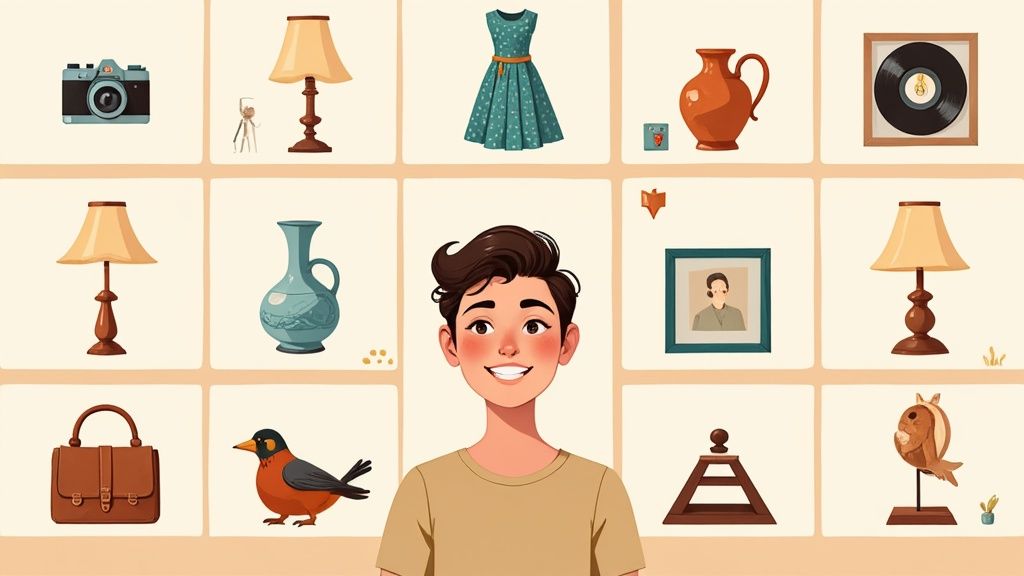Getting Started
Thrifting is more than just a hunt for bargains; it's a treasure hunt where history, craftsmanship, and incredible value hide in plain sight. From dusty bins to overlooked shelves, the potential for discovering a diamond in the rough is what keeps enthusiasts coming back. The thrill lies in not knowing what you might find, whether it’s a piece of iconic design history or a rare collectible that someone else unknowingly discarded. Uncovering the best thrift store finds requires a trained eye, a bit of luck, and a solid understanding of what to look for.
This guide moves beyond generic advice and dives deep into the specific categories that consistently yield the most rewarding discoveries. We will explore nine key areas, providing actionable insights to help you identify high-value items that others might miss. For each category, you will find:
- Detailed identification tips: Learn the specific marks, materials, and construction details that signal authenticity and value.
- Valuation insights: Understand the potential resale value of your finds, powered by market data.
- Sourcing strategies: Get practical tips on where and how to look for these specific items within a thrift store environment.
Whether you are a seasoned reseller, a dedicated collector, or a hobbyist looking to furnish your home with unique pieces, this listicle is your comprehensive roadmap to a more successful and profitable thrifting experience. Let’s begin the hunt.
1. Designer Handbags
Finding an authentic designer handbag at a thrift store is the holy grail for many shoppers and resellers. These are not mere accessories; they are high-value assets from iconic fashion houses like Chanel, Hermès, and Louis Vuitton that somehow slipped through the cracks and onto a donation shelf. The discovery of a $10 vintage Hermès Kelly bag, later valued at over $8,000, or a Louis Vuitton Speedy priced at $15, showcases the monumental return on investment possible. These instances are rare, but they highlight why designer bags are considered one of the best thrift store finds.
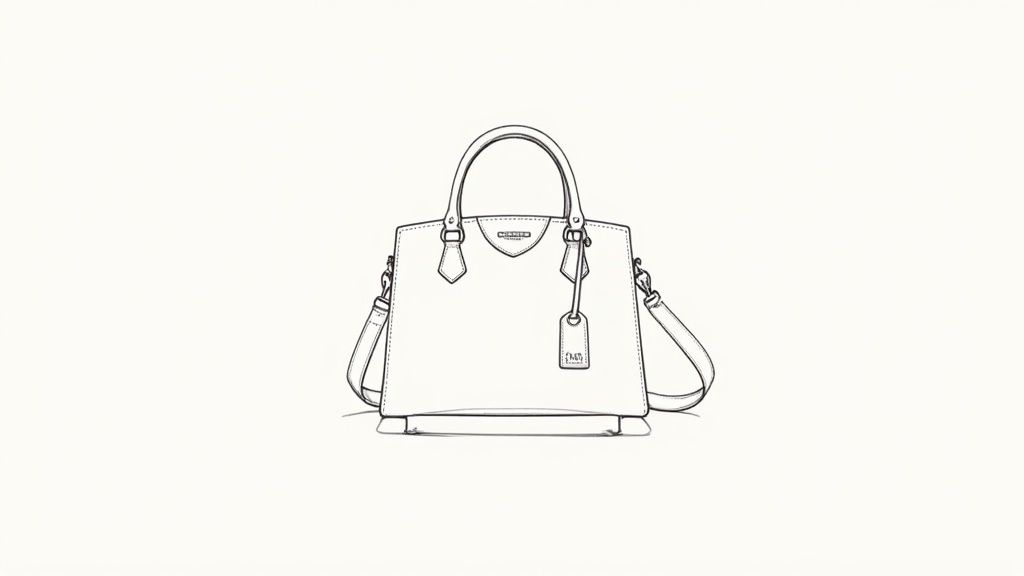
The primary challenge is separating genuine articles from the flood of counterfeits. Success requires a sharp eye and dedicated preparation before you even step into a store.
How to Spot an Authentic Designer Bag
Becoming proficient in authentication is non-negotiable. Start by focusing on one or two brands you're most interested in. Study their specific hallmarks of quality.
- Stitching: Authentic luxury bags feature precise, even, and tight stitching. Look for consistency in the stitch count per inch and the angle of the stitches. Messy, loose, or uneven threads are immediate red flags.
- Hardware: Examine the zippers, clasps, and logos. High-end brands use heavy, quality metals that won't flake or tarnish easily. Zippers should glide smoothly. Many brands, like Hermès, use specific stamps on their hardware.
- Serial Numbers and Date Codes: Research the specific format for the brand you're examining. A Louis Vuitton date code, for example, tells you the week and year it was made, while Chanel uses a serial number sticker with a corresponding authenticity card.
- Material Quality: Feel the leather or canvas. Genuine leather has a distinct smell and texture, while counterfeit materials often feel plasticky or cheap.
Building a good rapport with the staff at your local thrift stores can also provide an edge. They may give you a heads-up when a promising donation comes in, giving you the first look at what could be a life-changing find.
2. Vintage Vinyl Records
Unearthing an original pressing vinyl record at a thrift store is a music lover's dream and a collector's jackpot. These aren't just old LPs; they are artifacts of music history from legendary artists like The Beatles, Led Zeppelin, or Miles Davis. Finding a first pressing of a classic album can be incredibly lucrative. For instance, a first-run numbered copy of The Beatles' 'White Album' bought for $3 could be worth over $500, or an original pressing of Led Zeppelin I found for $2 could be valued at $300. These discoveries make vintage vinyl one of the best thrift store finds for those with a keen eye and ear.
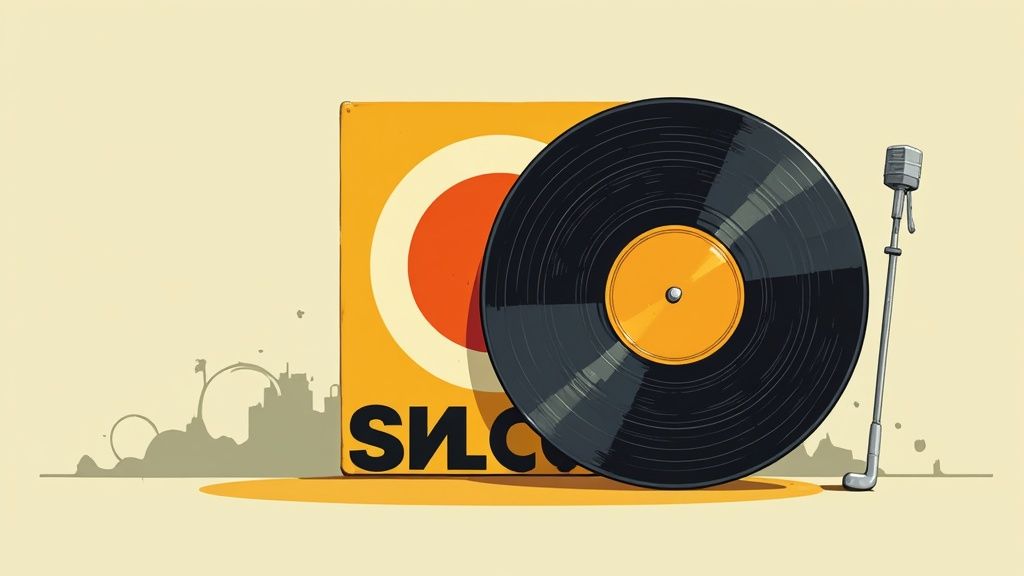
The biggest hurdle is distinguishing valuable first pressings from the mountains of common reissues. Success hinges on careful inspection and knowing what to look for before you even start flipping through the crates.
How to Spot a Valuable Vintage Record
Learning to identify key identifiers is essential for vinyl hunting. Focus on the details that separate a rare gem from a common record.
- Matrix Numbers: This is the most crucial detail. Look for the string of letters and numbers etched into the run-out groove (the blank space between the last track and the label). These codes identify the specific pressing plant and version. Use online databases like Discogs to cross-reference these numbers and confirm if you have a first pressing.
- Label Variations: Record labels often changed their designs over the years. A "deep groove" on the label, for example, can indicate an early pressing from the 50s or 60s. Research the label history for the artist you're inspecting to know what an original label should look like.
- Cover and Sleeve Condition: Carefully examine the album cover and inner sleeve. Look for wear, seam splits, and ring wear. The record itself should be checked for scratches and warping. A record in "Near Mint" (NM) or "Very Good Plus" (VG+) condition will always command a higher price.
- Original Inserts: The presence of original items like posters, lyric sheets, or custom inner sleeves significantly increases the value and desirability of a record. Make sure everything that was originally included is still there.
Using your smartphone in the store to quickly look up matrix numbers on Discogs can be a game-changer. This allows you to verify a record’s pressing and its current market value on the spot, ensuring you don’t leave a valuable piece of music history behind.
3. Mid-Century Modern Furniture
Discovering a piece of mid-century modern (MCM) furniture at a thrift store is a find that can transform a room and offer incredible value. Characterized by clean lines, organic curves, and functional design, pieces from the 1950s to the 1970s by designers like Charles and Ray Eames or Hans Wegner are highly coveted. Finding an Eames-style lounge chair for $50, later valued at over $3,000, or a sleek Knoll credenza for $75, showcases why this furniture style is one of the best thrift store finds for both design lovers and resellers.
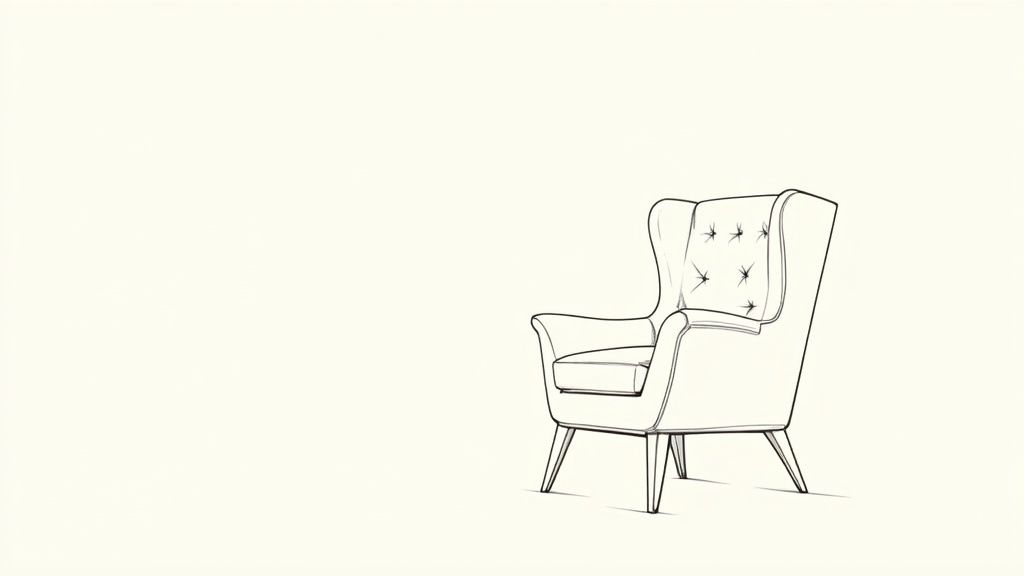
The key to success is distinguishing authentic period pieces from later reproductions or similarly styled items. Developing your eye for the specific details of MCM design is crucial before you start hunting.
How to Identify Authentic Mid-Century Modern Furniture
Familiarizing yourself with the icons of the era is the first step. Focus on a few designers or manufacturers to learn their signature styles and construction methods.
- Designer Marks & Labels: Look for manufacturer labels, stamps, or brand marks. Brands like Knoll, Herman Miller, and Lane Furniture often have identifiable markings on the underside, inside drawers, or on the back of a piece.
- Construction Quality: True MCM furniture was built to last. Check for solid wood construction (especially teak, walnut, and rosewood), dovetail joints in drawers, and sturdy, well-integrated legs. Avoid particle board and flimsy construction.
- Design Elements: Note the signature features of the style. Tapered legs, geometric shapes, and a minimalist aesthetic are classic indicators. The hardware should also feel substantial and match the period's style.
- Assess Condition: Evaluate the piece for any damage. While some wear can add character, significant issues like deep gouges, broken frames, or extensive water damage might require costly professional restoration. You can learn more about how to identify antique furniture and its key characteristics.
Building a relationship with thrift store employees can be invaluable. They can alert you when large furniture donations arrive, giving you the first chance to snag a timeless piece before it's gone.
4. Vintage Pyrex and Corningware
Spotting vintage Pyrex and Corningware on a thrift store shelf is like finding a piece of mid-century history. Prized for their durability, nostalgic charm, and iconic designs, these glass cookware pieces are highly sought after by collectors and vintage enthusiasts. Discovering a rare 'Lucky in Love' pattern bowl for $3, later valued at $150, or a complete Atomic Eyes mixing bowl set for $10, which can fetch up to $200, shows the incredible value hidden in plain sight. These finds prove why vintage glassware remains one of the best thrift store finds available.
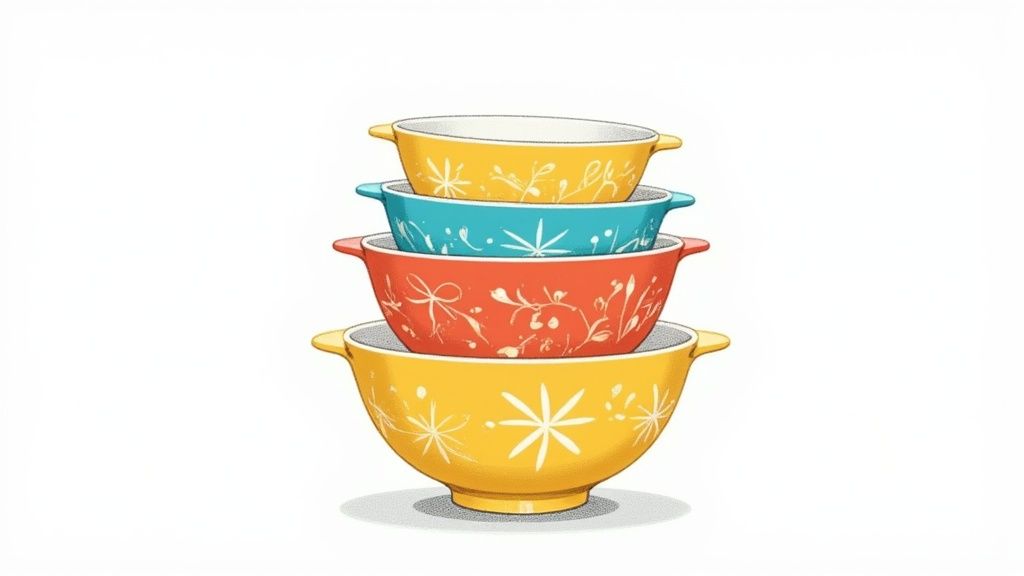
The key to success is distinguishing valuable, rare patterns from the more common, mass-produced items. A little bit of homework can turn a casual browse into a profitable hunt.
How to Identify Valuable Vintage Glassware
Knowing what to look for is essential. Focus on identifying the patterns and markings that signal a rare and valuable piece.
- Learn the Patterns: Familiarize yourself with highly sought-after patterns. For Pyrex, these include "Pink Stems," "Gooseberry," "Butterprint," and the ultra-rare "Lucky in Love." For Corningware, the "Blue Cornflower" is common, but rarer patterns like "Floral Bouquet" or "Spice O' Life" with specific variations hold more value.
- Check Condition Carefully: Inspect each piece for chips, cracks, and deep scratches. Pay close attention to the printed pattern. Fading or dishwasher damage, often called "dishing," can significantly decrease an item's value.
- Verify the Markings: Flip the piece over to find the backstamp. Authentic vintage Pyrex will have a mark indicating it was made in the USA, often in all capital letters. The type of stamp can help date the piece. Similarly, Corningware has distinct markings that verify its authenticity.
- Research Rarity: Not all vintage is valuable. Use online collector communities, forums, and pattern identification guides to quickly check the rarity and going rate for a pattern you find. This helps you know immediately if a $5 dish is a standard piece or a $100+ collectible.
Connecting with other collectors in online groups can provide invaluable knowledge. They often share recent finds, pattern information, and tips for spotting fakes or less common variations, sharpening your eye for your next thrift store visit.
5. Vintage Band T-Shirts
Uncovering a genuine vintage band t-shirt is a thrilling discovery for music lovers and collectors alike. These aren't just old clothes; they're wearable pieces of music history, representing iconic tours and cultural movements from the 1970s through the 1990s. Finding a 1975 Led Zeppelin tour shirt for $8, later valued at $800, or a Nirvana 'Nevermind' promo shirt for $5, worth $400, demonstrates the incredible potential value hidden on the racks. These finds are why vintage band tees are consistently ranked among the best thrift store finds.
The biggest challenge is distinguishing authentic, period-correct shirts from modern reproductions that flood the market. Developing a keen eye for detail is essential before you even start digging through the t-shirt bins.
How to Spot an Authentic Vintage Band T-Shirt
Knowing the key markers of a genuine vintage tee is crucial for success. Focus on the era and bands you're most interested in to become an expert in their specific merchandise characteristics.
- Tags and Labels: Examine the tag. Many authentic shirts from the 70s and 80s were printed on brands like Hanes, Screen Stars, or Fruit of the Loom. Research what tags were used during specific decades. The tag's material, stitching, and country of origin (often "Made in U.S.A.") are important clues.
- Stitching: Look at the hem and sleeve stitching. True vintage shirts, typically pre-mid-1990s, feature a single stitch construction. Modern shirts almost always use a double stitch. This is one of the quickest and most reliable ways to identify a potential vintage find.
- Print Quality and Aging: Authentic vintage prints often show subtle cracking or fading, known as patina, that is difficult to replicate artificially. The graphic should feel like a part of the fabric rather than a thick, plastic layer sitting on top, which is common with modern heat transfers.
- Fabric Feel: The material of an old cotton shirt will be noticeably thinner, softer, and more lightweight from decades of wear and washing. It should not feel thick, stiff, or heavily starched like a brand-new t-shirt.
Building a relationship with store employees can be invaluable. They might set aside promising band shirts they recognize, giving you the first chance to score a rare and valuable piece of rock and roll history.
6. Rare Books and First Editions
For bibliophiles and collectors, the dusty book aisle of a thrift store is a treasure map waiting to be deciphered. Finding a rare book or a first edition is one of the best thrift store finds because these items can hold immense historical and monetary value. A signed Stephen King first edition found for $2 could be worth over $500, while a 1960s Julia Child cookbook priced at $3 might be valued at $200. These are not just old books; they are artifacts of literary history hiding in plain sight.
The main challenge is distinguishing a truly valuable volume from the thousands of mass-market paperbacks. Success depends on knowing what to look for on the copyright page and understanding the physical markers of a valuable book.
How to Spot a Valuable Book
Identifying a first edition or a rare copy requires a methodical approach. Focus on the details that publishers use to denote print runs and authenticity.
- Copyright Page: This is your primary source of information. Look for the phrase "First Edition" or "First Printing." Another key indicator is a number line; a true first edition will typically have a full line that includes the number "1" (e.g., 1 2 3 4 5 6 7 8 9 10).
- Dust Jacket: The presence and condition of the original dust jacket are critical. For many modern first editions, the dust jacket can account for over 80% of the book's value. Check for the original price and any text that might indicate it's from a later book club edition.
- Binding and Condition: Examine the book's overall condition. Tight binding, clean pages, and minimal wear are essential. Signed copies are a huge bonus, but you must research the author's signature to verify its authenticity.
- Author and Publisher: Certain authors and publishers are more collectible. Early works from famous authors like Ernest Hemingway or J.K. Rowling are highly sought after. Researching specific publishers and their first edition identification practices can give you an edge.
When scanning shelves, be systematic. A quick check of the copyright page on any promising hardcover book takes only a few seconds and could lead to an incredible discovery.
7. Vintage Cameras and Photography Equipment
The resurgence of film photography has transformed old cameras from dusty shelf-sitters into highly sought-after treasures. Discovering a vintage camera from a legendary manufacturer like Leica, Hasselblad, or Canon is a major score for photographers and collectors alike. These finds are not just nostalgic objects; they are functional tools capable of producing stunning images. Unearthing a Leica M3 for $25, later valued at over $1,200, or a classic Canon AE-1 with a lens for $15, showcases the incredible potential hidden in thrift store electronic bins. These instances prove why vintage cameras are one of the best thrift store finds.
The main hurdle is distinguishing a functional, valuable piece from a broken one destined to be a prop. A quick inspection can reveal whether you've found a gem or just a paperweight.
How to Spot a Valuable Vintage Camera
A few key checks can help you assess a camera’s condition and potential value right in the store aisle. No advanced tools are needed, just a keen eye.
- Test Mechanical Functions: Without film, you can still test the basics. Wind the film advance lever and press the shutter button. Does it fire with a satisfying click? Test different shutter speeds to hear if they sound distinct. A working shutter is a massive plus.
- Check the Lens: Unscrew the lens if possible and hold it up to a light source. Look through it from both ends. You are checking for scratches, dust, and, most importantly, fungus, which looks like fine, spidery webs. A clean lens is critical for photo quality.
- Inspect the Body and Light Seals: Look for major dents or damage that could indicate it was dropped. Open the back of the camera and check the foam light seals around the door. If they are gummy or crumbling, they will need to be replaced, which is a common and relatively easy fix.
- Battery Compartment: Open the battery compartment to check for corrosion. Heavy, green, or white powdery residue can indicate a serious issue that might have damaged the camera's electronics, especially in models that rely on a battery for metering or shutter operation.
Familiarizing yourself with a few iconic models, like the Pentax K1000 or Minolta X-700, will help you quickly identify high-value, reliable cameras that are perfect for both use and resale.
8. Fine Art and Prints
Discovering original artwork or a limited edition print in a thrift store is like unearthing buried treasure. These finds range from charming pieces by local artists to signed prints from internationally recognized masters like Marc Chagall or Andy Warhol. Often donated without knowledge of their true value, a painting or lithograph priced at a mere $20 could be professionally appraised for thousands. A signed Chagall lithograph found for $20, later valued at $2,000, illustrates why fine art represents one of the most rewarding and best thrift store finds.
The main hurdle is distinguishing valuable art from mass-produced decor. Developing an eye for quality and knowing what to look for are essential skills for any art-hunting thrifter.
How to Spot Valuable Artwork
Becoming adept at identifying valuable art requires patience and research. Focus on learning the key indicators that separate a masterpiece from a simple print.
- Artist Signatures: Always check for a signature. Use your phone to do a quick search on the artist's name. Look for consistency in style and compare the signature to known examples online.
- Edition Numbers: For prints, look for a fraction like "25/100" in a corner, usually in pencil. This indicates it is part of a limited edition run, making it more valuable than an open-edition poster.
- Quality and Medium: Examine the piece up close. Can you see brush strokes on a painting? Does a print show the tell-tale dots of a modern commercial printer or the fine detail of an etching or lithograph? The texture and material can reveal its origin.
- Gallery Labels and Framing: Check the back of the piece. Labels from established galleries or custom framers can be clues to an item's quality and provenance. This is a common tactic used when sourcing from estate sales as well. You can learn more about sourcing art at estate sales on curio.app.
Taking the time to carefully inspect the art section can lead to incredible discoveries. A quick search on your phone can be the difference between walking past a hidden gem and taking home a valuable piece of art history.
9. Vintage Jewelry and Watches
The glass display case at the thrift store checkout counter often holds treasures easily overlooked by the casual shopper. Finding fine jewelry, vintage costume pieces, or classic timepieces is a frequent occurrence for those who know what to look for. These are not just decorative items; they can be valuable assets made from precious metals or designed by renowned jewelers and watchmakers. Discoveries like a Rolex Submariner for $30, later appraised at over $5,000, or a classic Art Deco diamond brooch found for $15 and valued at $800, prove why this category represents some of the best thrift store finds available.
The biggest hurdle is distinguishing valuable pieces from mass-produced costume jewelry and replicas. Success hinges on careful inspection and knowing the subtle signs of quality and authenticity.
How to Spot Valuable Jewelry and Watches
Developing an eye for detail is crucial for identifying high-value items among the jumble of necklaces and rings. Focus your efforts on learning the key identifiers of quality craftsmanship.
- Check for Maker's Marks: Look for tiny stamps or engravings on clasps, the inside of rings, and the back of pendants or watches. These marks can indicate the metal content (e.g., 14k, 925), the manufacturer (e.g., Tiffany & Co.), or the designer.
- Examine Stone Settings: Genuine jewelry typically features stones that are set securely with prongs, in bezels, or through other professional setting techniques. Glued-in stones are almost always a sign of inexpensive costume jewelry.
- Assess Overall Condition: Look for signs of wear and tear, but also for quality. A well-made vintage piece will feel substantial. For watches, check for smooth movement of the hands and quality hardware on the band.
- Test Metals When Possible: While you can't bring an acid kit into a store, you can carry a small jeweler's loupe to inspect for markings. A magnet is also useful; precious metals like gold, silver, and platinum are not magnetic.
Learning how to properly identify valuable pieces takes time and practice. For more detailed guidance, you can learn more about how to identify antique jewelry on curio.app. A little knowledge can turn a quick glance at the jewelry case into a highly profitable discovery.
Top 9 Thrift Store Finds Comparison
| Item | Implementation Complexity 🔄 | Resource Requirements ⚡ | Expected Outcomes 📊 | Ideal Use Cases 💡 | Key Advantages ⭐ |
|---|---|---|---|---|---|
| Designer Handbags | High – requires authentication expertise and market research | Moderate – needs expert knowledge and possible cleaning/repair | Very high resale value; investment potential | Luxury collectors, fashion resellers, thrifters | Authentic luxury at low cost; status symbol; timeless value |
| Vintage Vinyl Records | Medium – knowledge of pressings and condition grading required | Low to moderate – condition inspection and research | Appreciating collector value; cultural and audio quality | Music collectors, audiophiles, nostalgia seekers | Unique analog sound; historical significance; wide genres |
| Mid-Century Modern Furniture | High – needs authentication, restoration skills | High – heavy items, possible refurbishing | Strong resale, interior design appeal, investment returns | Interior designers, collectors, furniture enthusiasts | Timeless design; quality craftsmanship; versatile décor |
| Vintage Pyrex and Corningware | Low to medium – pattern recognition and careful handling | Low – basic inspection for damage and pattern rarity | Collectible value with functional use | Kitchen collectors, retro enthusiasts, everyday users | Durable, decorative, affordable entry point |
| Vintage Band T-Shirts | Medium – requires authentication and print verification | Low – careful condition check and research | High collector demand; wearable investment | Music fans, vintage fashion enthusiasts, collectors | Cultural significance; strong resale; wearable art |
| Rare Books and First Editions | High – needs deep knowledge and authentication | Low to moderate – condition and rarity assessment | Potentially very high value; cultural and educational worth | Bibliophiles, collectors, investors | Compact storage; multiple value factors; literary importance |
| Vintage Cameras and Photography Equipment | High – technical knowledge and functional testing | Moderate – requires condition and operational checks | Collectible and functional use; photography investment | Film photographers, collectors, camera enthusiasts | Quality optics and mechanics; niche market demand |
| Fine Art and Prints | High – requires art expertise and provenance verification | Moderate – care in handling and authentication | Potential for extraordinary value; aesthetic appeal | Art collectors, decorators, investors | Cultural and investment value; unique artistic expression |
| Vintage Jewelry and Watches | High – needs expert authentication and appraisal | Low to moderate – detailed inspection and testing | High value-to-size ratio; wearable investment | Jewelry collectors, investors, fashion users | Compact value; timeless appeal; strong resale market |
Final Thoughts
The journey through the aisles of a thrift store is more than just a shopping trip; it's a modern-day treasure hunt. As we've explored, the potential for discovering extraordinary value is immense, from the supple leather of a forgotten designer handbag to the iconic lines of Mid-Century Modern furniture. The key to unlocking this potential lies not in luck, but in knowledge, patience, and a well-trained eye. The best thrift store finds are rarely the ones screaming for attention. Instead, they are the quiet marvels hiding in plain sight, waiting for someone who knows what to look for.
This guide has equipped you with the foundational knowledge to spot these hidden gems. We've covered the subtle maker's marks on vintage Pyrex, the tell-tale signs of a first edition book, and the specific construction details that separate a genuine vintage band t-shirt from a modern reprint. Each item, from rare vinyl records to timeless jewelry, carries its own set of identifiers and clues. Mastering these details is what transforms a casual browser into a seasoned and successful hunter.
From Browsing to Building Expertise
Your journey doesn't end here. The most critical takeaway is that successful thrifting is an active, ongoing practice. It's about building a mental catalog of brands, patterns, materials, and historical context. To elevate your skills and consistently uncover the best thrift store finds, you must commit to continuous learning and application.
Here are your actionable next steps:
- Specialize and Focus: While it's fun to look for everything, start by focusing on one or two categories from this list that genuinely interest you. Whether it's vintage cameras or fine art, deep expertise in a niche area will yield better results than surface-level knowledge across the board.
- Create a Thrifting Toolkit: Assemble a small bag with essentials for your trips. Include a magnifying glass or jeweler's loupe for examining marks, a tape measure for furniture, your smartphone for quick research, and a list of specific brands or items you're hunting for.
- Document Your Finds (and Non-Finds): Take photos of interesting items, even the ones you don't buy. Note why you passed on them. Was the condition poor? Was it a reproduction? This practice sharpens your evaluation skills and helps you recognize fakes or damaged goods more quickly in the future.
The True Value of the Hunt
Ultimately, the pursuit of the best thrift store finds offers benefits far beyond monetary gain. It's a powerful way to engage with history, champion sustainability, and curate a life filled with unique, meaningful objects that tell a story. Each successful find is a victory for conscious consumerism, keeping a beautiful and functional item out of a landfill and giving it a second life. This practice cultivates a deeper appreciation for craftsmanship, design, and the enduring quality of things built to last. So, go forth with your newfound knowledge, embrace the thrill of the hunt, and start building your own collection of incredible stories and treasures.
Ready to take the guesswork out of valuation and identify your finds with confidence? Curio uses advanced AI to analyze photos of your items, providing instant identification, historical context, and accurate market value. Stop wondering and start knowing what your best thrift store finds are really worth by visiting Curio today.
